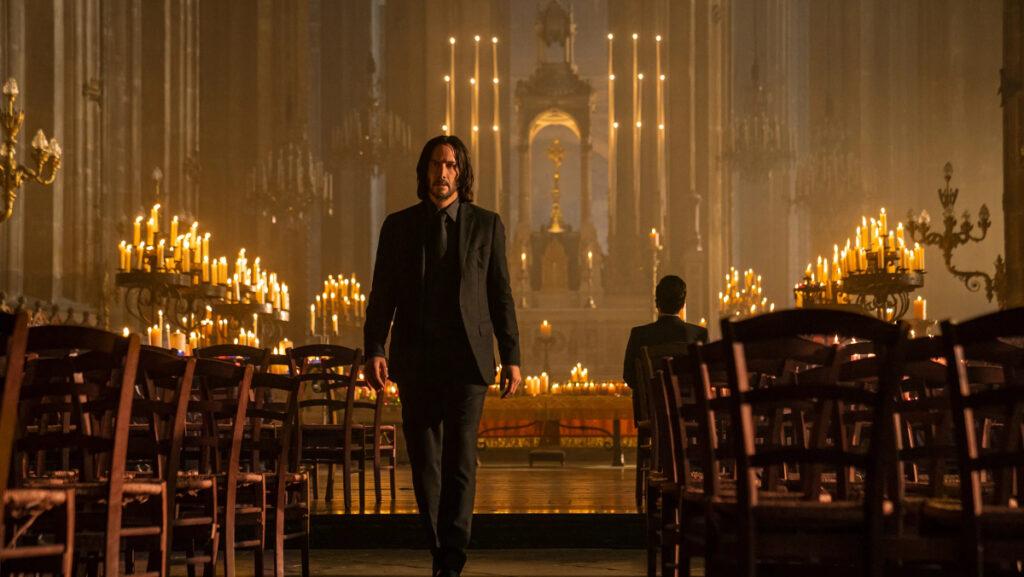For nearly a decade, the “John Wick” franchise has redefined the action genre and pushed the limits of what practical stunt work can accomplish. In “John Wick: Chapter 4,” stuntman and director Chad Stahelski has perfected the balance between compelling plotlines and nonstop adrenaline-pumping thrills. Stahelski has already cemented “John Wick” as one of the most energetic action franchises to ever exist. In this latest entry, he has crafted not just the best film in the franchise but one of the greatest action films of all time.
In “John Wick: Chapter 4,” John Wick (Keanu Reeves) is still a wanted man whose bounty seems to only increase with every breath he draws. In a play for his freedom from the all-powerful High Table, he travels around the world assembling everything he would need in challenging Marquis Vincent de Gramont (Bill Skarsgård) to a duel to the death.
A core tenet in “Chapter 4” is that actions have consequences and those who break the rules must face those consequences by any means necessary. From its opening moments, ramifications for choices made in the last film are laid in front of the audience to witness. The higher stakes established so early into the film’s nearly three-hour runtime plays into the epic feeling that it carries.
“Chapter 4” is a sprawling adventure that only gets better with each passing scene. From its first incredible major action sequence set in Osaka, Japan, the film dials everything viewers have come to expect from the series’ signature visceral and bloody action up to an 11. Just when viewers think “Chapter 4” simply cannot top itself, it bumps up the action even further.
The action sequences in “Chapter 4” are some of the most amazingly creative and stylish set pieces ever put to screen. It is dizzying to think about how Stahelski and his team accomplished the feats of each sequence. Whether it be a mesmerizing, sweeping overhead crane sequence that captures the franchise’s video-game-like feeling and tone better than ever or a gunfight that sees Wick fight his way up a mountainous 222-step stairway, it cannot be overstated how breathtaking the intricate stunt choreography in “Chapter 4” is.
“Chapter 4” is also the best looking and sounding “John Wick” film yet. Cinematographer Dan Laustsen uses the film’s settings to capture some visually gorgeous shots that dazzle the senses. Laustsen leaves the idea of shaky-cam at the door and understands that the best visual action is seen through as few cuts as possible. The musical score by Tyler Bates is also significantly improved when compared to past films. Bates uses the score to further engage viewers and heighten the action’s excitement. When a scene is slower and more mysterious in tone, the frenetic score matches it to heighten the intrigue. When a scene features a bombastic action sequence, the music is fast-paced and just as powerful a force of nature as Wick himself.
As the character of John Wick has become more iconic over the years, so too has Reeves, who only gets better in the role. Reeves’ unique line delivery and acting choices are part of his charm and a defining characteristic of Wick’s character. How Reeves performs much of the film’s stunts himself will always be impressive. In “Chapter 4,” though, Reeves succeeds remarkably at taking his character to a deeper place thematically.
Skarsgård is fantastic as de Gramont, an arrogant member of the High Table who means business, yet always dispatches others to take care of his bloody business for him when it is most difficult. While viewers never fully fear his presence, Skarsgård is intimidating enough in the role to earn viewers’ hate.
New side characters Caine (Donnie Yen) and Mr. Nobody (Shamier Anderson) are welcome additions to the core cast. Both of these characters brighten the screen when they appear and leave viewers clamoring for more of them in possible spin-offs. In particular, Yen’s blind assassin is a scene stealer, uttering some of the best lines in the whole franchise.
Winston (Ian McShane) and the Bowery King (Laurence Fishburne) remain welcome supporting players as well. McShane is given more opportunities to flesh out Winston more emotionally in “Chapter 4” while Fishburne remains an entertaining presence who chews scenery better than anyone.
“Chapter 4”’s scale is unparalleled and unlike what most CGI-heavy action films can offer. It is on par with some of the best action films of the last 10 years, like “Mad Max: Fury Road” (2015) and “Mission Impossible: Fallout” (2018), which similarly revolutionized the genre. Its story and action are both satisfying in their perfection. If Stahelski had been developing a formula for crafting mind-blowing action sequences, he has mastered that formula in “John Wick: Chapter 4.” Cinema has never seen anything quite like it and it is unlikely it will be topped anytime in the near future.




















